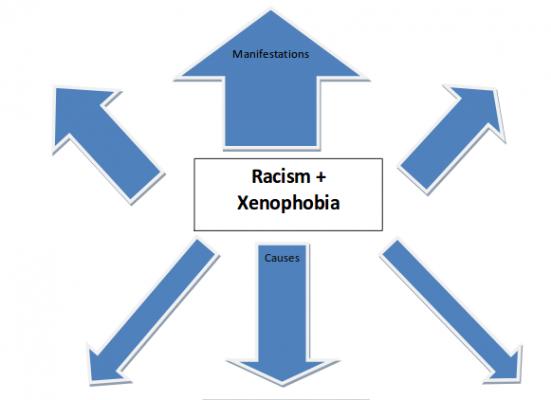

Learning resource
Tackling racism, antisemitism and xenophobia
- To understand the meaning of racism, antisemitism and xenophobia
- To understand the motivation behind racism, antisemitism and xenophobia
- To understand the damage caused by racism on a micro, meso and macro level
- To develop skills and attitudes to take an active stance against racism and antisemitism
An overview of racism and xenophobia by the teacher (presentation attached can be used).
Following the presentation, the teacher splits the class into buzz groups, i.e. small groups of 3-4 persons to discuss for 15 minutes the key findings, impressions and learning outcomes. After that, students discuss the buzz group findings in a plenary. It is important for the teacher to remain a facilitator rather than express opinions.
Again in small groups of 3-4, learners work for about 40 minutes on the problem tree to identify root causes, manifestations and impacts of racism and xenophobia (on a micro, meso and macro) level. Each group will present its tree to the rest of the class and discussions will ensue.
The method ends in an open discussion on the key findings, learning outcomes and impressions of the process.
Presentation on racism, antisemitism and xenophobia (attached).
The teacher leading the activity should be familiar with the concepts of racism, antisemitism and xenophobia. The following material is useful for this purpose:
- UNESCO - Xenophobia
- European Commission - Racism and Xenophobia
- Teaching material to challenge antisemitism
Printed copies for each group (3-4 persons per group) or a power point image of the problem tree (attached).
Hold an open evaluation session during which learners discuss:
- What they learnt;
- Ideas on what steps can be taken at school level to tackle racism and antisemitism;
- What role learners have in tackling racism and antisemitism.
Designate an 'anti-racism' week in the school during which several activities and events take place to tackle racism and raise general awareness on the theme. Allow learners to be at the epicentre of these activities so as to facilitate the development of knowledge, skills and attitudes.
Invite a speaker to give a presentation on the subject. This could be someone who has experienced racism or is a representative of a relevant association/NGO involved in such issues so as to offer students ground information.
Implement activities from the following handbook, produced by the Council of Europe:
English
Portuguese, Portugal
Slovenian
German
Romanian
French
Spanish
Italian
Greek
Dutch
